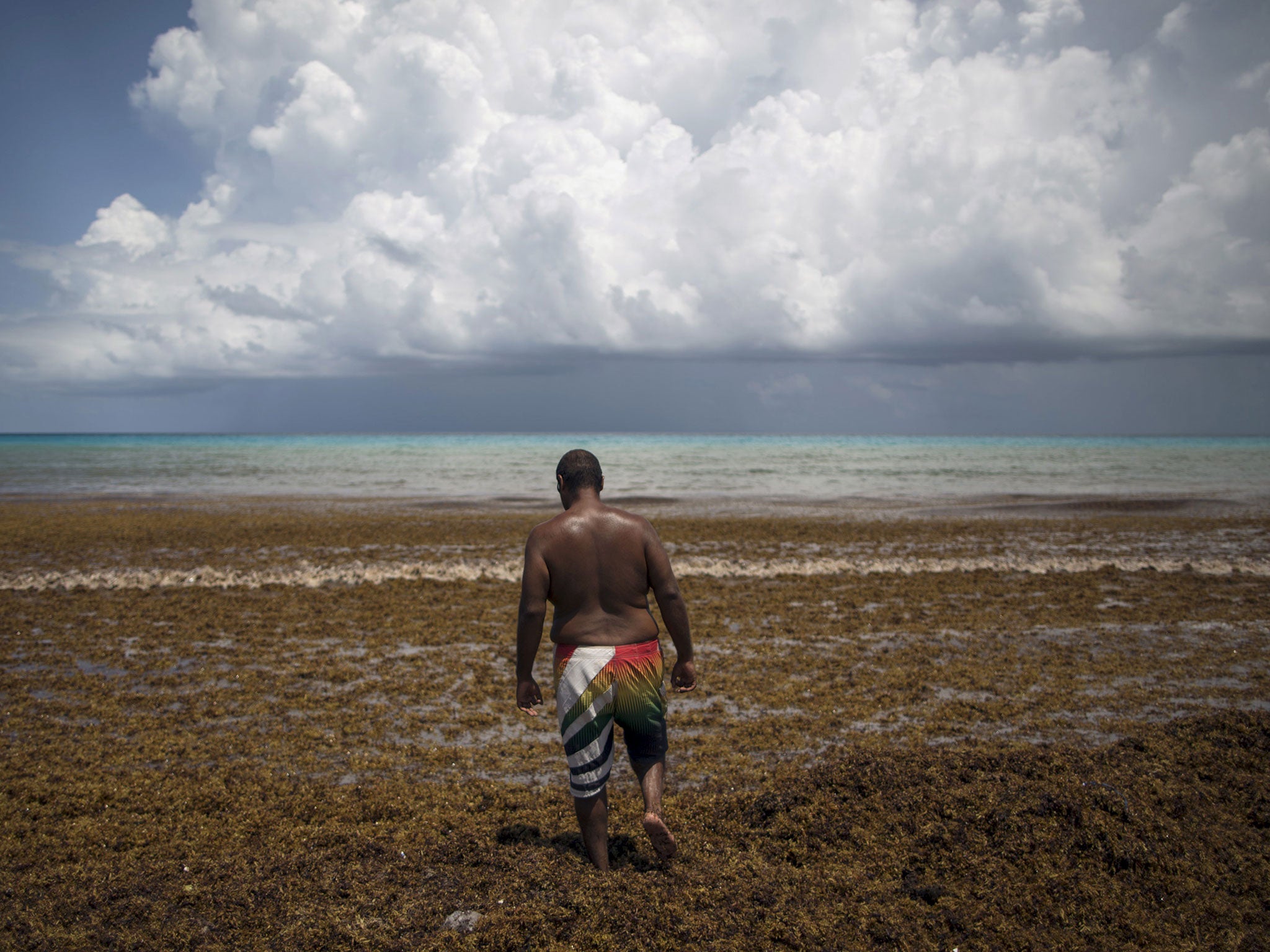Mexico’s holiday beaches buried as mystery seaweed invasion hits Cancun
The country's Caribbean coastline attracts more than 10 million visitors and generates billions of pounds in tourism-related revenue a year, so the situation has become a cabinet-level crisis

Surrounded by a four-man camera crew, the Japanese honeymooners were ready to make memories.
In their wedding whites, the couple leapt off the beach and kicked their heels. Their photo shoot was perfect, if you could ignore the smelly strip of brown algae fouling the white sands.
“It’s disgusting,” photographer Juan Manuel Delgado said. “I’ve worked on the beaches for 21 years, and this has never happened before.”
From Barbados to Belize, Cancun to Tulum, a brown seaweed known as sargassum has invaded the Caribbean basin this year. Vast floating mats have washed up and buried beaches. The piles of seaweed grew more than four feet high in Antigua, while Tobago’s legislature declared a natural disaster last month as the stench of decomposing seaweed, and the dead fish and turtles caught within it, caused nausea among tourists.
Hilary Beckles, vice chancellor of the University of the West Indies, called it “the greatest single threat to the Caribbean economy I can imagine”.
For Mexico, whose Caribbean coastline attracts more than 10 million visitors and generates billions of pounds in tourism-related revenue a year, the arrival of sargassum became a cabinet-level crisis. When José Eduardo Mariscal de la Selva, director general of Cancun’s maritime department, received a photo from his beach cleaners one morning in July, he assumed it was a joke. Within days, the country’s tourism and environment ministers were touring Cancun to assess the calamity.
“Beaches are what we sell to the whole world and what we depend on... for all our income,” he said.
Since the July invasion, Mexico has launched a clean-up effort; the federal government has budgeted £6m so far to remove the mess. Along the coast of Quintana Roo state, the government hired 5,000 labourers in four-hour shifts to rake seaweed from more than 100 miles of beach. From one popular stretch in Cancun, they hauled off half a million cubic feet of seaweed – more than 1,000 lorry-loads, Mr Mariscal said.
Tourists are not going to want to set one foot in this town because of the pestilence here
The Mexican navy has deployed oceanographers to track the seaweed and has launched research voyages to study “what provoked this arrival”, said Rear Admiral Fernando Alfonso Angli Rodriguez. There are also proposals to buy boats and floating barriers to block the algae before it reaches the beaches.
This type of seaweed is not new to these parts. The 15th-century explorer Christopher Columbus noted its abundance, and it is how the Sargasso Sea, in the North Atlantic, got its name. But this year’s bloom has baffled scientists. Chuanmin Hu, a professor of optical oceanography at the University of South Florida, who tracks the sargassum by satellite, said that the summer of 2015 showed the largest coverage in history.
Scientists have offered various theories, such as climate change having shifted ocean currents. “What caused this?” the professor asked. “That is still a mystery.”
Along the most popular Cancun tourist beaches, authorities have made headway, particularly as the amount of sargassum washing up has eased in recent weeks. But farther south, in places such as Akumal, Tulum and Mahahual, visitors still have to deal with piles of seaweed. “I don’t mind it so much,” said Stefano Bilosi, 29 – an Italian honeymooner in Akumal, but his wife, Federica Brentaro, interjected: “I don’t like the stuff.”
The frantic clean-up has prompted its own backlash, as environmental groups protest against the use of bulldozers to move seaweed mountains.
Hotel owners are also not happy. “The cruises are going to arrive in October, and the tourists are not going to want to set one foot in this town because of the pestilence here,” said Cristobal Aguilar, who runs the Hotel Arenas in Mahahual. His hotel is offering 25 per cent discounts to attract customers willing to ignore the vegetative stench.
© The Washington Post
Subscribe to Independent Premium to bookmark this article
Want to bookmark your favourite articles and stories to read or reference later? Start your Independent Premium subscription today.

Join our commenting forum
Join thought-provoking conversations, follow other Independent readers and see their replies